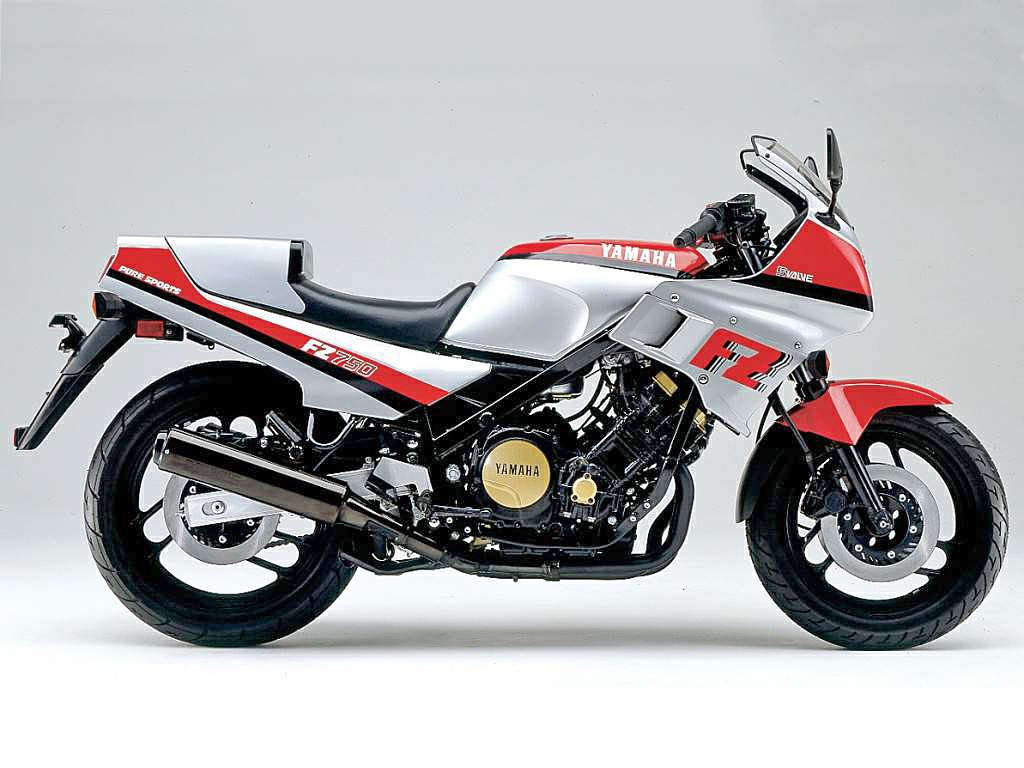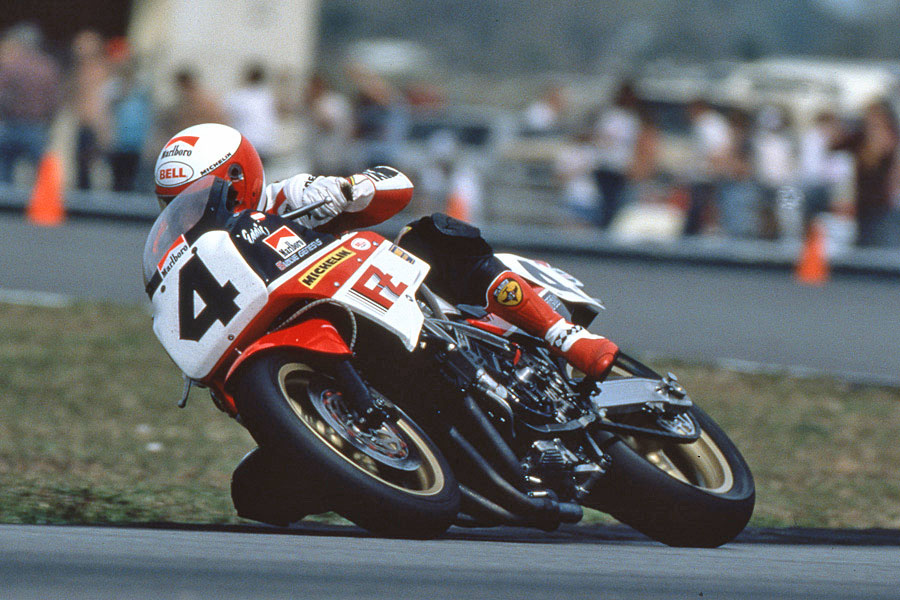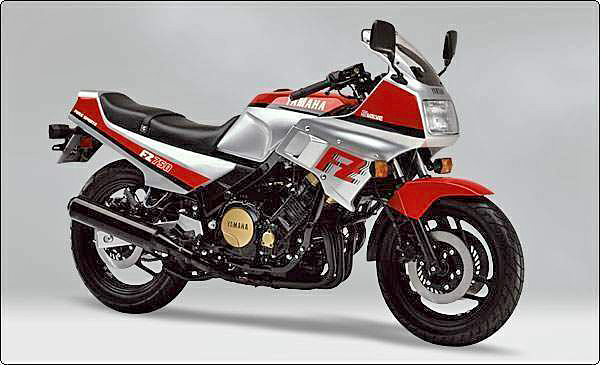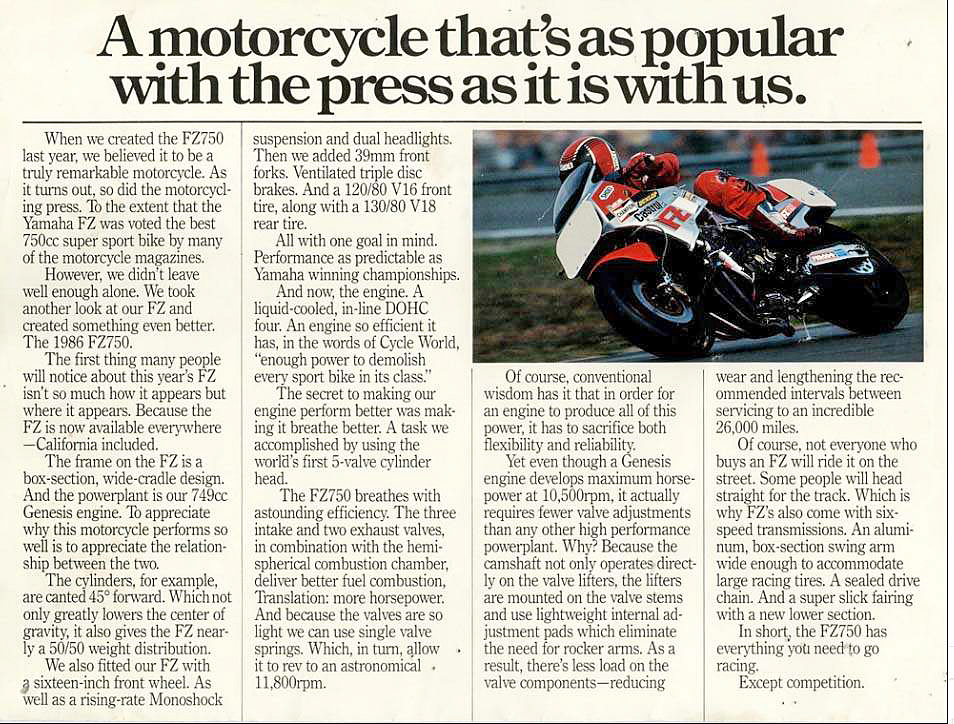Motorcycle Investor mag
Future collectible - Yamaha FZ750
(March 2020)
by Guy 'Guido' Allen

Force Five
Yamaha’s breakthrough five-valver deserves more recognition
It’s funny to see, across the decades, motorcycles we once saw as hero bikes slip into some sort of obscurity. The victim I have in mind was once a force to be reckoned with both in the showroom and on the racetrack – namely Yamaha’s FZ750. These days, I suspect there aren’t that many people who know what one is, or could tell you much about it.

Here’s the thing: in production form it won two Castrol Six-Hour production races in a row – 1985 and 1986 – with Richard Scott and Paul Feeney beating a GPz900R the first year, while Michael Dowson and Kevin Magee shut the gate on a GSX-R750 the next. In superbike form, it won the Daytona 200 in 1986, with Eddie Lawson (pictured above) in the saddle, beating Wayne Rainey on a Honda and Kevin Schwantz on a Suzuki. With that sort of track record, you’d expect to see the odd one mounted on a plinth. But no, over the years it quietly sank out of sight.
The FZ was effectively the fourth entrant in a four-way Japanese sport bike war. First came Honda’s VF750F V-four Interceptor, then Kawasaki GPz900R, Suzuki’s GSX-R750 and then, nanoseconds later, the FZ750. This was the era of the 16-inch front wheel, driven by the then current tech used in grands prix. Of this group, Suzuki alone resisted the impulse to go down that path.
When you look back at the competing offerings from the big four Japanese makers, the GSX-R was the stand-out, pitched as a very hard-edged sports bike – really an endurance racer replica. It also became the longest-standing nameplate.

Yamaha, like Honda and Kawasaki, decided to make its entrant a more user-friendly unit than the Gixxer, with a few more creature comforts. It was much more the conventional road bike, though it represented a huge leap in thinking from its XJ750 predecessor.
Without question the highlight and the talking point was the Genesis five-valve engine. With three inlet and two exhaust valves per cylinder, it was seen as something of a breakthrough design, offering a very amiable and flexible power delivery. Yamaha said it had toyed with the idea of seven-valve heads, but the production costs were prohibitive.
Running a fairly high 11.2:1 compression ratio, the engine was fed with a bank of 34mm Mikuni carburettors. Its claimed 100-plus horses (72kW) and verifiable 230km/h top speed put it very much on a par with the competition, while the revlimiter was set at a dizzy 11,800rpm. Yamaha was quick to announce a superbike upgrade kit for the engine, which claimed 130 horses.
For the day-to-day owner, one potential concern might have been the expense of checking and adjusting 20 valves, but service intervals were set at an incredibly generous 42,000km.
Aside from the number of valves, the mechanical spec was relatively conventional, with a six-speed transmission and wet clutch. However it was the packaging which made the key differences between this and its predecessors. Every effort was made to keep down the width of the inline four, the cylinders of which were canted 45 degrees forward. Yamaha said this was aimed at keeping the weight low and helped to give the bike a 50-50 balance.
Where it lost out to the Gixxer 750 was size and weight. It was substantially longer in the wheelbase and carried an additional 20-plus kilos. However that was anything but a deal-breaker. Racers at the time argued the FZ was a more comfortable mount, causing less fatigue, which made their job easier during an endurance race.

The FZ chassis borrowed some thinking from the bigger FJ1100 flagship, in that it ran a perimeter-style frame constructed of box-section steel. It might look a little agricultural in this age of twin-spar alloy frames, but at the time it was a good bit of kit.
Up front you scored a non-adjustable 39mm fork, while the rear scored a monoshock adjustable for preload. Braking was by two-piston calipers up front and a single-spotter on the rear. Imagine trying to flog a sports bike these days, with such basic spec!
All up, it proved to be a very reliable package – arguably the pick of what was then available in the showrooms. I recall doing an in-service survey on these things back in the late 1980s, and their reputation with owners was second to none.
As a ride, they were a seriously quick road bike. The engine would spin up quickly and produced solid midrange, with a noticeable kick in the pants around the 7000rpm mark. Though not as light as a GSX-R, an FZ750 was still a good 20 kilos or more lighter than most of its performance predecessors, with a far more solid chassis, making it a very potent package.
Yamaha did not throw a whole lot more development at the series, as its efforts would soon be concentrated on the new FZR1000 – its sports flagship that debuted in 1987. The FZ750 was essentially unchanged for 1985-86, but we saw a couple of updates for the 1987-88 model years. They included a 17-inch front wheel, four-piston front calipers and a full rather than half fairing (see below).

It’s interesting that Yamaha was willing to step away from the FZ designation in the 750 class, after four short years. Clearly it wanted to make a clean break from the road-oriented product. There was a much-upgraded and updated FZR750R sports bike available in 1988-89 to satisfy world superbike homologation, but really the company seemed to take a bit of a holiday from this class until the appearance of the YZF750R series started rolling into showrooms in 1993.
Exactly why the FZ750 has fallen into obscurity is a bit of a mystery. It earned plenty of competition kudos during its brief career, but perhaps it was hampered by what was then a rapidly-shrinking motorcycle market. At $5600 it was price competitive with its closest racing rival – the GSX-R – and you would have thought Lawson’s legendary superbike win might have been enough to see them selling like the proverbial hotcakes. Apparently not.
Finding a good example will take patience, as there don’t seem to be many in the market. An ordinary one can be had for around $4000, while I reckon a good one could easily fetch double that figure. Though not as glamorous as some of its more sporty successors, it fills an important place in Yamaha’s street bike history and, to my way of thinking, is currently undervalued.
***
Good
Fast
Ultra reliable
Useful road bike
Bad
Very few good ones left


Click here to see the brochure pics at full size.
SPECS:
Yamaha FZ750 1985
ENGINE:
TYPE: Liquid-cooled, five-valves-per-cylinder, inline four
CAPACITY: 749cc
BORE & STROKE: 68 x 51.6mm
COMPRESSION RATIO: 11.2:1
FUEL SYSTEM:4 x 34mm Mikuni CV carbs
TRANSMISSION:
TYPE: Six-speed, constant-mesh,
FINAL DRIVE: Chain
CHASSIS & RUNNING GEAR:
FRAME TYPE: Steel box-section perimeter
FRONT SUSPENSION: conventional fork 39mm, nil adjustment
REAR SUSPENSION: Monoshock, preload adjustment
FRONT BRAKE: 270mm discs with two-piston calipers
REAR BRAKE: 270mm disc with one-piston caliper
DIMENSIONS & CAPACITIES:
DRY WEIGHT: 209kg
SEAT HEIGHT: 782mm
WHEELBASE: 1710mm
FUEL CAPACITY: 22lt
TYRES:
FRONT: 120/80-16
REAR: 130/80-18
PERFORMANCE:
POWER: 72kW @ 10,500rpm
TORQUE: 81Nm @ 8000rpm
OTHER STUFF:
PRICE NEW $5900 + ORC
-------------------------------------------------
Produced by AllMoto 61 400 694 722
Privacy: we do not collect cookies or any other data.


Archives
Contact


